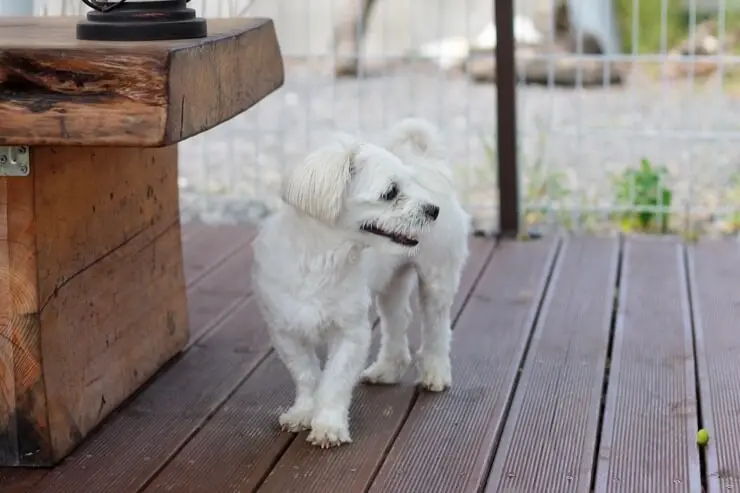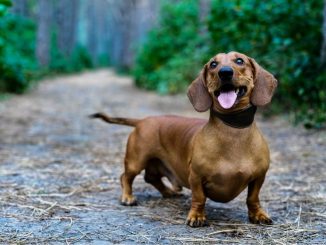
From Adobe Stock
Schweenies, a mix between a Shih Tzu and a Dachshund, are as unique as they come. They have this joyful energy that lights up the room and loyalty that makes them stick by your side like a true friend. Oscar, my Belgian Malinois, was initially puzzled by the little, bold newcomer to our kennel, but quickly became its playmate, showing how these small dogs can win over hearts, big and small.
In this article, I’m going to share everything you need to know about Schweenies. From their playful personality to their caring nature, and yes, even their stubborn streaks. I’ll also touch on the best ways to take care of them, making sure they live a happy and healthy life. If you’re curious about this adorable mix or considering adding one to your family, this article is for you.
TABLE OF CONTENTS
- Schweenie Quick Breed Summary
- History and Origin of the Shih Tzu Dachshund Mix
- Physical Characteristics of the Schweenie
- Schweenie Personality and Temperament
- Common Health Concerns for Shih Tzu Dachshund Mix
- Caring for a Schweenie
- FAQs on Schweenies
- The Perfect Teddy Bear Mix
- More Shih Tzu and Dachshund Mixes
Schweenie Quick Breed Summary
| Breed Mix Name: | Schweenie, Shih Tzu Dachshund Mix |
| Size: | 11-20 inches |
| Weight: | 9-20lb |
| Lifespan: | 10-14 years |
| Coat: | Long or medium single coat |
| Color: | Rust, tan, black, white or merle |
| Do They Shed: | Moderately |
| Temperament: | Alert, independent, affectionate and sweet |
| Intelligence: | High |
| Socialization: | Very friendly when socialized from a young age |
| Destructive Behavior: | Destructive when distressed or under-stimulated |
| People Skills: | Eager to please and makes friends easily |
| Good with Children: | Yes (aged 6+) |
| Activity Levels: | Moderate |
History and Origin of the Shih Tzu Dachshund Mix
A protective hunting hound mixed with a lovable toy breed makes for one of the most loyal friends you can ask for— a Schweenie. It’s a cute, cuddly lap dog with high intelligence and a hunting instinct.
Before we discuss this mix, let us look at the parent breeds.
Shih Tzu
The Shih Tzu is a breed that’s always fascinated me, especially with its long, flowing coat and that aristocratic look it carries so effortlessly. The origin story takes us back to ancient China, where these dogs were highly treasured by Chinese royalty. It’s like they were born to be pampered and adored, sitting on the laps of emperors and empresses. They’re one of those breeds that make you think of luxurious palaces and royal gardens when you see them.
Breeding Shih Tzus has always been about preserving their elegance and unique personality. They’re not just pretty faces; their history is rich, believed to have been developed by monks in Tibet who then gifted them to Chinese royalty. This royal connection shaped their breeding, ensuring they maintained their status as dogs of luxury and leisure.
Physically, these dogs are quite distinctive. They’re small but sturdy, with a proud head and a soft, long coat that comes in many colors. Their eyes are like little sparkles of joy, and their face has this sweet, almost human-like expression that melts hearts. They require regular grooming to keep their coat in top shape, which is something I’ve spent countless hours doing for the ones in our care.
Temperament-wise, Shih Tzus are a bundle of affection and friendliness. They thrive on human companionship and love being part of the family. Despite their royal roots, they’re surprisingly down-to-earth and enjoy nothing more than a cuddle on the couch. However, they can have a stubborn streak, which I’ve noticed when trying to train them. But their charm and eagerness to please usually win out in the end.
Dachshund
Oh, Dachshunds, those little adventurers with personalities much bigger than you’d expect from their pint-sized bodies! I’ve had the pleasure of spending quite a bit of time with them, and they never fail to make me smile with their antics. Their history as badger hunters in Germany is fascinating to me. It’s like they still carry that bold, fearless spirit in their tiny frames, always ready to take on the world.
Breeding these little guys has always been about keeping that spunky hunting spirit alive, along with their distinct long bodies and short legs. Whether they’re the standard or miniature size, or sporting a smooth, long-haired, or wire-haired coat, each Dachshund has its own charm. I’ve brushed a few long-haired ones, and let me tell you, it’s both a challenge and a joy.
Living with them, even if just during their stay at the kennel, has shown me how much personality they pack. They’re not just dogs; they’re little bundles of courage, always curious and ready to explore every nook and cranny. They’ve got this incredible loyalty to their families, becoming fiercely protective over their loved ones. And while they can be a bit stubborn when it comes to training, their eagerness to be involved and play makes up for it. They’re like little comedians, always up to something that’ll have you laughing.
Honestly, every day with a Dachshund brings something new. Their bravery, wrapped up in that adorable, elongated body, reminds me that size really doesn’t matter when it comes to heart and spirit.
Physical Characteristics of the Schweenie

From Adobe Stock
When looking at the Schweenie, a mix between a Shih Tzu and a Dachshund, you’ll find there’s no set standard for their appearance, which is something I really appreciate. Each Schweenie brings its own unique look to the table, though they often share some common physical traits.
They usually have an elongated body, much like their Dachshund parent, giving them a distinctive shape. This feature is pretty noticeable, especially with their short legs that add to their unique profile. Their ears are long and floppy, which, alongside their large eyes and prominent noses, adds to their expressive faces.
Height and Weight
In my experience, adult male Schweenies can reach heights of 15-20 inches and weigh between 15 and 20 pounds. The females tend to be smaller, usually not exceeding 15 inches in height, with weights ranging from 9 to 15 pounds. It’s always fun to see how they confidently move around on their short legs, regardless of their size.
Breed Colors and Coat
Schweenies can sport a wide range of colors. The most common color pattern I’ve seen is rust or tan brown against a white background. However, it’s not unusual to come across brown, black, or merle coats. Sometimes, a Schweenie might even showcase a mix of all the possible breed colors, which is always a pleasant surprise.
The coat of a Schweenie can vary in length and texture, from long or medium length, and it might be coarse, shaggy, or silky. This variety mostly depends on which parent breed they take after more.
Schweenie Personality and Temperament

From Adobe Stock
The Schweenie temperament is something special, a blend of characteristics that seems to hit the jackpot in terms of balance. From my time spent with these delightful mixes, I’ve noticed they strike a perfect middle ground between being lively companions and calm, cuddly friends. Despite their toy breed lineage, which often leans towards lapdog behavior, Schweenies bring a bit of zest without overwhelming energy. This makes them fantastic companions for those living in smaller spaces or cities, where their moderate energy levels fit right in with indoor living.
Intelligence and empathy shine through in Schweenie’s personality, traits I’ve seen firsthand. They’re not just smart; they’re also incredibly in tune with their owners’ emotions, which can be a double-edged sword. Their cleverness sometimes means they can be a bit manipulative to get their way, especially when those big, expressive eyes are hard to say no to.
Now, about their vocal nature, thanks to the Shih Tzu influence, they do tend to be vocal. Combine that with the Dachshund’s hunting dog vigilance, and you might think you’re in for a lot of noise. However, from what I’ve experienced, Schweenies can be taught quite effectively to curb excessive barking. It’s something that, with a bit of patience and consistency, can be managed well.
Socialization is key with these little ones. Both of their parent breeds can have a shy streak, so it’s important to introduce your Schweenie puppy to a variety of experiences and friends early on. They generally get along well with cats, small dogs, and other small animals, making them great for a household with multiple pets. However, care should be taken around larger dog breeds, as the size difference can be a bit much for them.
Common Health Concerns for Shih Tzu Dachshund Mix
Understanding these issues not only helps in identifying symptoms early but also in taking preventive measures. Below, I’ll delve into some of the health issues that are known to affect Schweenies.
Dry Eye Syndrome (Keratoconjunctivitis Sicca)
One of the health challenges Schweenies may face is dry eye syndrome or keratoconjunctivitis sicca. This condition occurs when the tear glands don’t produce enough moisture to keep the eyes well-lubricated, leading to redness, irritation, and a thick discharge from the eyes. The cause is often inflammation of the tear glands, and it can have a genetic component, making some Schweenies more predisposed to it than others.
Luxating Patella
Another common issue in Schweenies is a luxating patella, where the kneecap dislocates or moves out of its normal position. It’s especially prevalent in smaller breeds. Signs that your Schweenie may be experiencing this include a noticeable reluctance to stand or walk, an abnormal gait, or sudden yelps of pain when moving.
I’ve noticed that the severity of a luxating patella varies; mild cases might be managed with anti-inflammatory medications and physical therapy to strengthen the muscles around the knee. However, more severe cases often require surgical intervention to realign the kneecap and prevent it from dislocating in the future.
Intervertebral Disc Disease (IVDD)
A significant health issue that can affect Schweenies is intervertebral disc disease (IVDD). This condition occurs when the cushioning discs between the vertebrae of the spinal column either bulge or burst, leading to pain, nerve damage, and in severe cases, paralysis. The symptoms can include reluctance to jump or move, pain and stiffness in the neck or back, difficulty walking, or complete loss of limb function. IVDD can be caused by genetics, trauma, or the natural aging process.
Dental Problems
Dental problems are also common in Schweenies, partly due to their small mouths which can lead to overcrowding of teeth. This overcrowding can make them more prone to tartar buildup, gum disease, and tooth decay. Symptoms of dental issues include bad breath, difficulty eating, red or swollen gums, and visible tartar on the teeth.
Caring for a Schweenie

From Adobe Stock
I’ve learned that understanding their specific needs is crucial to keeping them happy and healthy. Whether it’s finding the right food, keeping them active without overdoing it or managing their grooming routine, I’ll cover all you need to know to provide the best care for your furry friend.
Exercise
Some new owners assume that because it’s a small dog, it doesn’t need much exercise. Under-exercising any dog, especially a toy breed like the Schweenie, isn’t a good idea. Without enough activity, they can lose muscle tone and even start showing behavior problems.
Schweenies aren’t usually the type to go crazy with high-energy play, but they do love engaging in activities that challenge their brains. They’re quite happy with around 15 minutes of playtime each day, whether indoors or out. And yes, they do have a bit of a digging instinct, which can be pretty cute unless it’s your garden they’re redecorating! I’ve found that setting up little scavenger hunts or playing hide and seek with their toys can keep them entertained and mentally stimulated.
When it comes to walks, twice a day works well for Schweenies. All in all, they should get about 45 minutes of exercise daily. This routine helps keep their body in shape and their mind sharp, plus it’s a great way for you both to bond. Just remember, the goal is to keep them active and engaged, not exhausted.
Training a Shih Tzu Dachshund Mix

From Adobe Stock
Training Schweenies is quite the journey because they have this eager-to-please attitude that’s genuinely heartwarming. When they nail a command or trick, showing them how impressed I am with loads of cuddles and ear scratches seems to light up their world.
But, of course, their stubborn streak can surface now and then, making some training sessions more challenging. I’ve noticed that patience and adapting to their pace, rather than forcing them, yields better results. It’s important to tackle any manipulative or spoiled behaviors early on, setting clear boundaries.
Ignoring them when they bark without cause often works wonders over time. They gradually learn when it’s appropriate to voice out and when to stay quiet. Keeping their sharp minds engaged is crucial due to their low tolerance for boredom. This means incorporating games into their training routine to keep things interesting.
Hide and seek with their toys is a fantastic game I’ve seen work well. It not only taps into their intelligence but also uses their keen sense of smell. Whether played indoors or outdoors, it’s a fun way to strengthen your bond.
Grooming
Grooming a Schweenie is an essential part of their care that goes beyond just keeping them looking good; it’s about maintaining their health and happiness. Their coat type, whether it leans more towards the silky Shih Tzu or the wiry Dachshund, will determine much of your grooming routine. In the following sections, I’ll break down the key grooming activities for taking care of your Schweenie, sharing insights on how to keep them in tip-top shape.
Brushing
Regular brushing is crucial for keeping a Schweenie’s coat smooth and free of mats, especially if they have inherited the longer, silkier coat of the Shih Tzu. I recommend brushing them at least a few times a week with a suitable brush that reaches down to their undercoat. This not only helps to remove loose fur and prevent tangles but also distributes natural oils throughout their coat, keeping the fur healthy and shiny. For Schweenies with shorter, Dachshund-like fur, brushing can be less frequent, but it’s still important to keep their coat clean and well-maintained.
Bathing
Based on what I’ve seen, bathing them every three to four weeks is sufficient, using a gentle dog shampoo that’s kind to their skin. Always make sure to rinse thoroughly, as leftover shampoo can cause itching and flaking. And, of course, getting them used to bath time early on makes the process much smoother for both of you.
Ear Care
Schweenies often have floppy ears, which can be prone to infections if not kept clean and dry. Checking their ears regularly for signs of redness, bad odor, or unusual discharge is something I always do. Cleaning their ears gently with a damp cloth or a vet-approved ear cleaner can help prevent problems before they start. It’s a delicate process, though, so being gentle and patient is key.
Nail Trimming
I find that trimming their nails every few weeks, depending on how quickly they grow, helps to keep them comfortable. If you can hear their nails clicking on the floor, it’s probably time for a trim. For those who are nervous about doing this themselves, a professional groomer or vet can ensure it’s done safely.
Dental Care
Lastly, dental care is an often-overlooked aspect of grooming that’s vital for a Schweenie. Regular brushing of their teeth helps prevent tartar buildup, gum disease, and other dental issues. Starting dental care routines early and using dog-specific toothpaste can make this a much easier task.
Feeding a Schweenie
Below, I’ll guide you through the key aspects of feeding your Schweenie, covering everything from portion control to the type of food, feeding schedules, and how to handle treats.
Portion Control
Portion control is essential for preventing obesity in Schweenies, a common issue given their small size and potential for lower activity levels. I usually start by following the recommendations on the dog food package, adjusting as needed based on the dog’s age, weight, and activity level. It’s important to measure their food with a proper measuring cup to ensure accuracy. Overfeeding can lead to weight gain and health problems, so keeping a close eye on their portions is key. If you’re unsure, consult a vet to determine the ideal portion size for your Schweenie.
Feeding Schedule
Establishing a regular feeding schedule helps regulate your Schweenie’s digestion and keeps their energy levels steady throughout the day. From what I’ve observed, feeding adult Schweenies twice a day—once in the morning and once in the evening—works well. Puppies, on the other hand, require more frequent feedings, typically three to four times a day. Sticking to a consistent schedule not only aids in digestion but also helps with house training, as it makes their bathroom needs more predictable.
Food Type and Quality
The type and quality of food you give your Schweenie can have a significant impact on their health. I always recommend choosing a high-quality dog food that meets their nutritional needs, which can vary based on their age, health, and energy levels. Look for foods that list real meat as the first ingredient and avoid those with fillers and artificial additives. For Schweenies with sensitivities or specific health concerns, specialized diets may be necessary.
Treats and Snacks
Treats are a great way to reward your Schweenie during training sessions or as an occasional snack. However, it’s crucial to manage the amount and type of treats to prevent overfeeding. I tend to opt for healthy, low-calorie treats and keep them to less than 10% of the dog’s daily calorie intake. Also, using treats as a way to supplement their diet with extra nutrients or dental care benefits can be a smart choice. Remember, treats are just that—treats—and shouldn’t replace their regular, balanced meals.
FAQs on Schweenies
How long does a Schweenie live?
You can expect your lovable little mix to be with you for 10 to 14 years. This range is quite typical for dogs of their size and with good care, including proper diet, exercise, and regular veterinary check-ups, many Schweenies can enjoy a full and happy life within this lifespan.
How much does a Schweenie cost?
A Schweenie is an uncommon breed, so you might find yourself paying around $1200 for a puppy. This price can vary based on factors like the breeder’s reputation, the location, and the puppy’s lineage. While it might seem steep, remember that a healthy puppy from a reputable breeder often means fewer health issues—and lower vet bills—down the line.
Is the Schweenie a good family dog?
Schweenies make great family dogs because they adapt well to various living situations and are known for their loving and affectionate nature. They thrive on attention and interaction, expecting love from everyone in the family. It’s important, however, to teach children how to interact with them gently and respect their space, as Schweenies can be delicate and may get injured easily if handled too roughly.
Can Schweenies live in apartments?
Yes, Schweenies can be excellent apartment dogs due to their small size and moderate energy levels. They don’t require a backyard to be happy, but they do need daily walks and playtime to stay healthy and content. As long as they get enough exercise and mental stimulation, Schweenies can adapt well to apartment living.
Is it okay to travel with Schweenies?
Absolutely! These small, affectionate dogs are great travel companions due to their compact size and friendly disposition. With proper preparation, including ensuring their comfort, safety, and necessary supplies like food and water, traveling with your furry friend can be a delightful experience. Just remember to consider their needs and plan accordingly for a smooth journey.
Do Schweenies get along with other pets?
Schweenies generally get along well with other pets, especially if they are raised together or properly introduced. Their sociable nature means they can enjoy the company of other dogs and even cats. However, it’s always a good idea to supervise initial interactions and ensure all pets are comfortable and safe in each other’s presence.
How often do Schweenies need to be groomed?
The grooming needs of a Schweenie can vary depending on their coat type, which they inherit from their Shih Tzu and Dachshund parents. Typically, they require regular brushing a few times a week to prevent mats and tangles, especially if they have a longer coat. Bathing should be done every few weeks, and regular ear cleaning, nail trimming, and dental care are also important parts of their grooming routine.
Are Schweenies easy to train?
Schweenies can be easy to train due to their intelligence and eagerness to please. However, they may inherit a stubborn streak from their Dachshund lineage, so patience and consistency are key. Positive reinforcement techniques work best, and incorporating training into playtime can keep them engaged and make learning more effective and enjoyable for both of you.
The Perfect Teddy Bear Mix
The Schweenie is truly a bundle of joy and a perfect little companion for just about anyone willing to give them love, attention, and the occasional treat. Whether you’re in a cozy apartment or have a bit more space, these little guys will make themselves right at home, filling your life with their quirky charm and affectionate natures. Taking care of them, from making sure they’re well-fed and groomed to keeping them active and mentally stimulated, really isn’t too much of a hassle. Plus, it’s all worth it when you see how happy and healthy they are. Just remember, a little patience, a lot of love, and maybe a few belly rubs here and there, and you’ve got a friend for life.
More Shih Tzu and Dachshund Mixes
Want a Shih Tzu mix or a Dachshund mix but aren’t keen on the Schweenie? Check out these other hybrid dog breeds:















We just got a Schweenie and she is so freaking cute, loveable and adorable! She is very young (7 weeks old yesterday) and I am hoping we will be successful at training her – potty training and teaching her it is not okay to bite. My husband and I will be retiring in 2 years and plan to buy a motor home and traveling. I think she will be the perfect travel companion.